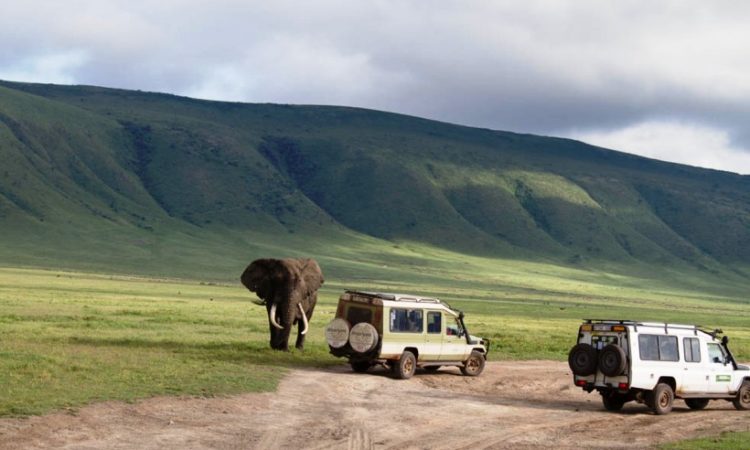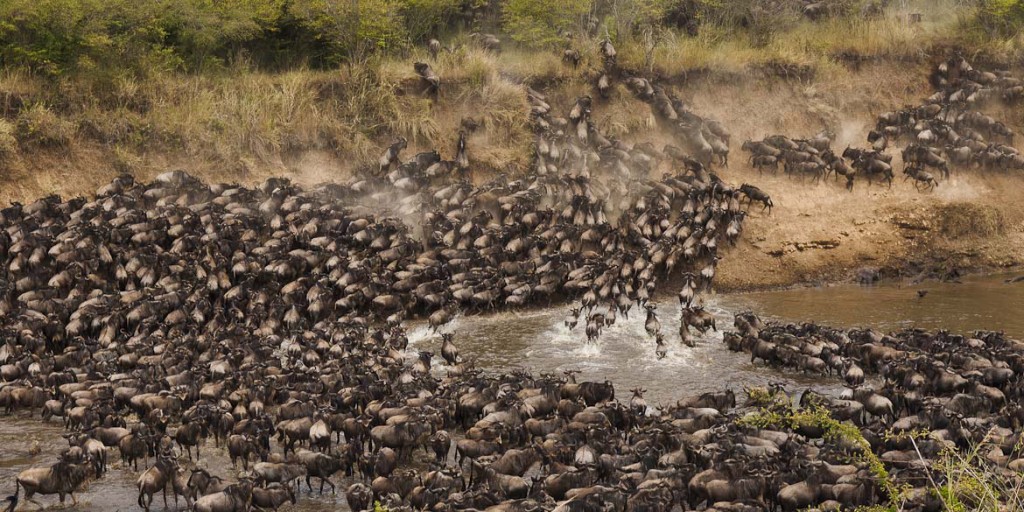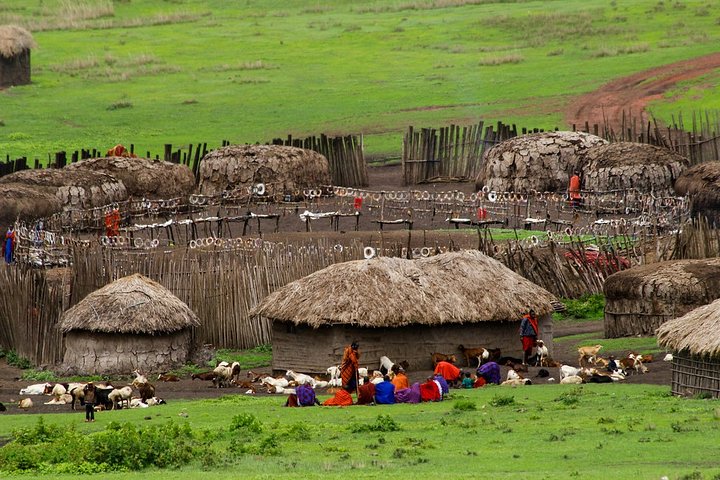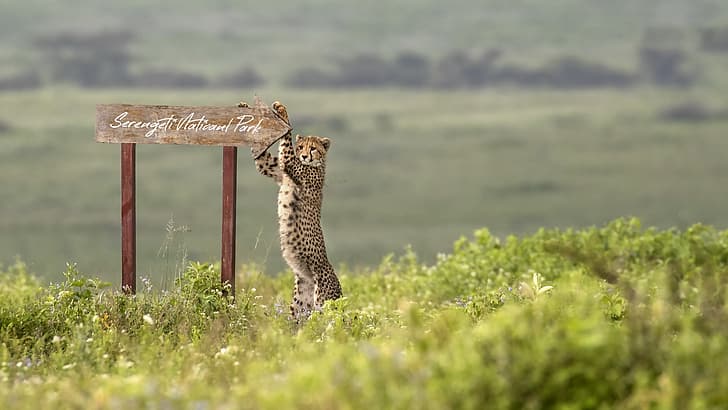Ngorongoro Crater Safaris : The Ngorongoro Crater is one of the most unique safari places in the world. There are bigger and wilder parks, but an Ngorongoro Crater safari will provide some of the simplest and most gratifying game viewing in East Africa.

On a longer safari trip, the Ngorongoro Crater is usually a two-or three-night stop. Safaris here are frequently paired with game drives in adjacent Lake Manyara National Park, Tarangire National Park, and the Serengeti National Park, which is home to the famed wildebeest migration. Northern Tanzania’s safari circuit is well-traveled, with adequate infrastructure and more accommodation options. Game drives in six-seater 4×4 safari vehicles with a professional naturalist driver and guide are typical of safaris in the Ngorongoro crater.
In addition, luxury tented lodges and basic campsites are available in the Ngorongoro area, with options at both ends of the scale offering panoramic views from the crater rim. Where you stay is determined by your budget and preferred vacation style. Small group trips frequently use the crater rim campgrounds, which can be chilly at night. Temperatures can plunge below zero in Tanzania’s winter, which runs from June through August. This is prime safari season, so dress warmly for early morning game drives in your Ngorongoro crater safari tour.

What can you expect to see on your Ngorongoro Safari?
The Ngorongoro Crater is well-known, especially during peak season, and for good reason. Safaris here are like a gigantic wildlife lottery: descend to the crater floor and you’ll almost certainly find a Big Five prize, sometimes all five. Game drives here regularly see lions, enormous bull elephants, giraffes, endangered black rhinos, and even elusive leopards due to the abundance of wildlife.
Because black rhinos are reasonably common here, the Ngorongoro Crater is one of the best spots in Tanzania and Kenya to see them. Seeing these extremely endangered animals is still a rare privilege, with only 26 individuals occupying a 260km2 crater bottom.
The Ngorongoro Crater is also known for having one of Africa’s densest lion populations, making sightings of the ‘King of the Jungle’ quite common. There’s no way around it in the Ngorongoro: you’ll be sharing your lions with other safari trucks. The Conservation Area Authority allows a maximum of five cars to be present around an animal or kill, but there is so much wildlife here that if things become too crowded, you can simply move on to find another lazing group.
Along with its animals, the Ngorongoro Conservation Area boasts some of the most breathtaking views in the Rift Valley. The crater rim is lined with lookouts, lodges, and campers that survey the crater floor, which is 600 meters below. At Heroes’ Point, the view that emerges from the dense rainforest is unrivaled.
Natural history on a human scale is also preserved in the protected area. The Olduvai Gorge, part of the larger Ngorongoro Conservation Area, has yielded some of the world’s oldest human remains, including a 1.75 million-year-old skull that has altered our understanding of human evolution.
What activities are available during your Ngorongoro safari?
If you have enough time to spend at this, one of Africa’s best safari parks, plan to partake in a variety of tourist activities on your safari tour to Ngorongoro. You’ll probably stop in the Olduvai Gorge the “Cradle of Mankind“—on your trip to or from the Ngorongoro Crater to learn more about its unique paleoanthropological significance.
Walking safaris with Maasai guides are available throughout the larger Ngorongoro Conservation Area (not in the crater itself) and are frequently included in excursions. If you walk along the crater rim for two to three hours, you’ll not only avoid the crowds at popular viewpoints, but you’ll also likely stumble across small Maasai towns and native nomadic herders. Longer walks lead you into the Olmoti Crater, which offers superb birdwatching, or to the flamingo-filled soda lake of Empakai Crater.
Many excursions include visits to one of the many Maasai communities that dot the crater’s surrounding area, where you may learn about traditional tribal life, dance, and crafts. However, because of the large number of visitors who visit the Ngorongoro area, these settlements may not provide the most authentic view of Maasai culture. Before visiting, choose a responsible tour operator (Focus East Africa Tours) and inquire about how you will be actually benefiting local Maasai communities.

Bird viewing, hiking safaris, a tour trip to Serengeti national park, a visit to shifting sands, a visit to Lake Natron, and other tourist activities can be included in your safari in the Ngorongoro crater.
When is the best time to go on an Ngorongoro safari?
Wildlife viewing in the Ngorongoro is less influenced by the seasons and large-scale migration patterns than in Tanzania’s other parks, making it a good year-round safari destination. The dry season, which lasts from June to October, attracts large numbers of big game due to decreasing waterholes. You’ll be able to combine safaris in the Ngorongoro with a chance to view large herds of wildebeest congregating on the Serengeti Plains as the Great Migration prepares to cross the Grumeti and Mara Rivers and continue north into Kenya in June and July. In Tanzania, this is peak safari season, which means higher rates and more people.
From November to December, just outside of peak season, might be a beautiful time to explore the Ngorongoro Crater. The brief rains have ended, leaving behind a beautiful, newly-green landscape, which is being relished by wildlife and fewer safari trucks. Baby animals arrive in the crater around late January or early February. Predators are on the prowl when the wildebeest and zebra herds greet their offspring. While this is the rainy season, the main downpours usually don’t start until March or April.
How to get to the Ngorongoro Crater for your safari tour?
Fly into Kilimanjaro International Airport via Dar es Salaam, Nairobi, or directly from Europe, then transfer to Arusha Airport. Note that international flights frequently arrive late at night, necessitating an overnight stay in Arusha. Many people opt to make the final transfer to their hotel at the crater or in the adjacent town of Karatu by road because the Ngorongoro Crater is only a 3.5-hour drive from Arusha. In the Ngorongoro Crater region, game drives and road transfers are conducted in open-sided 4x4s.
From Arusha, drive. Depending on the size of your group, sharing a private vehicle and guide from the time you are picked up from your international trip at Kilimanjaro Airport until you fly out of the Ngorongoro region may be less expensive. Leaving from Arusha You can fly into Lake Manyara airstrip and be picked up by the camp if you are staying at a “fly in” camp, which means your guide and car are provided by the camp rather than a ground handler from Arusha.
How is Ngorongoro Crater safari different from other park safaris?
The Ngorongoro Crater, the world’s biggest intact volcanic caldera, is the park’s wildlife-viewing showpiece, with 260km2/100mi2 of damp savannah walled in by steep 600m/1968ft high walls capped by a cover of lush montane forest.
The crater is one of the world’s most beautiful natural wonders even without the wildlife, but it also serves as a unique refuge inside a sanctuary with abundant fauna and a vast scenic scale that has drawn analogies to the biblical Garden of Eden. There is nothing else like Ngorongoro crater it in Africa.
What is the cost of an Ngorongoro Crater Safari?
When it comes to the cost of a safari in the Ngorongoro crater, there are several aspects to consider, including the kind of accommodation, the number of days on safari, the time of year you visit (seasonality), and the number of people you visit on your vacation. To know more about the cost of your safari to Ngorongoro your more advised to contact us (FOCUS EAST AFRICA TOURS) to get a real cost and more information about your Ngorongoro safari holiday.
Combining a Ngorongoro Crater Safari with Other Destinations
You’re lucky if you have planned a booking and visit in Ngorongoro crater, the crater is surrounded by some of the popular and ultimate safari park including the Serengeti national park so it is easy to combine your safari itinerary from Ngorongoro to other destinations. The Serengeti National Park, Tarangire National Park, Lake Manyara National Park, Mount Kilimanjaro, and Arusha National Park are all prominent sites along the northern Tanzania Safari Circuit.

Where to stay in your Ngorongoro safari holiday?
The Ngorongoro Crater is extremely popular as one of the highlights on many East African itineraries. When choosing which Ngorongoro Crater accommodation to book, consider not only the availability of lodging but also the crater’s accessibility as well as your budget.
There’s wonderful lodging on the rim of the Ngorongoro Crater, with some of the best views in Africa, if not the world. If you stay at one of these prime-location lodges, you’ll be first in line to drive down to the crater floor in the morning, but for a more affordable Ngorongoro safari experience in a similarly tranquil and scenic setting, head to Karatu, which is located 20 kilometers south of the crater in the green rolling hills of the Karatu Highlands.
Exclusive and luxury lodges are located on the crater’s rim. Their views are among the best in the world, and their service is top-notch, making for an ideal Ngorongoro honeymoon. Visitors staying near the crater in the nearby town of Karatu, however, will travel for about an hour before reaching the caldera, but the lodging is more inexpensive, smaller, and intimate. Many of the lodges and guest rooms also provide additional activities like local walking tours and horseback riding.


